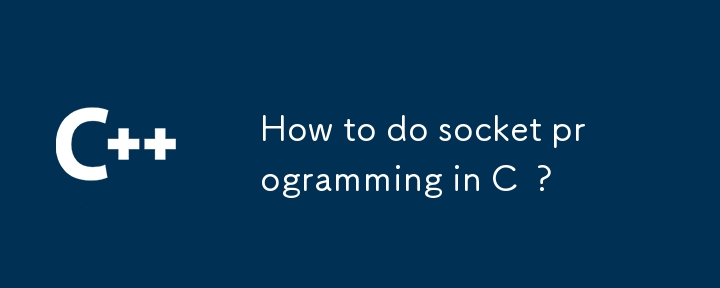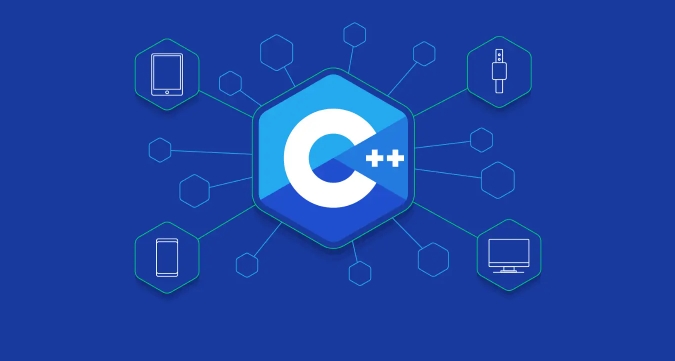The core of C socket programming lies in mastering network communication processes and system API usage. The main steps are: 1. Create sockets on the server, bind addresses, and listen to connections; 2. Create sockets on the client, set addresses and connect; 3. Send and receive data through read/write; 4. Pay attention to error handling and cross-platform differences. The sample code shows how to initialize the server socket, bind the port, listen to the connection, and how the client initiates the connect request. When communicating, the data needs to be processed using a buffer and the return value is judged to deal with the blocking problem. In addition, Linux uses close and Windows uses closesocket to close, and Windows needs to call WSAStartup first. A complete implementation should include error checking to ensure the robustness of the program.

The core of writing C socket programming is to understand the basic process of network communication and be familiar with the API provided by the system. I won’t talk about the underlying principles here, I will only talk about how to actually operate in C.

Basic steps: Create socket, bind address, listen to connection (server side)
For server programs, the main processes include:

- Create a socket
- Bind IP and port
- Start monitoring
- Receive client connections
- Send and receive data
The sample code structure is roughly as follows:
int server_fd = socket(AF_INET, SOCK_STREAM, 0);
struct sockaddr_in address;
address.sin_family = AF_INET;
address.sin_addr.s_addr = INADDR_ANY;
address.sin_port = htons(8080);
bind(server_fd, (struct sockaddr *)&address, sizeof(address));
listen(server_fd, 3);
while (true) {
int client_fd = accept(server_fd, nullptr, nullptr);
// Process client_fd
} Note: socket() , bind() , listen() and other functions are system calls. -1 will be returned when an error occurs. Remember to add an error check.

How to connect to the server by the client?
The client is relatively simple, mainly specifying the server's IP and port, and then initiating a connection request.
Key steps:
- Create a socket
- Set server address information
- Call
connect()
Sample code snippet:
int sock = socket(AF_INET, SOCK_STREAM, 0); struct sockaddr_in serv_addr; serv_addr.sin_family = AF_INET; serv_addr.sin_port = htons(8080); inet_pton(AF_INET, "127.0.0.1", &serv_addr.sin_addr); connect(sock, (struct sockaddr *)&serv_addr, sizeof(serv_addr));
If the connection is successful, you can send and receive data through read() and write() .
Data sending and receiving: Don't forget about buffer and blocking issues
By default, socket is blocking, that is:
- If there is no data to read,
read()will get stuck - If the other party fails to accept it,
write()may also be stuck
So a few things to note:
- Use a fixed-size buffer to send and receive data, such as
char buffer[1024]; - Check the return value to determine whether it has finished reading or writing failed
- If you don't want to block, you can set it to non-blocking mode, but it's a little more complicated to handle.
Let’s give a simple example of sending and receiving:
char buffer[1024] = {0};
read(client_fd, buffer, 1024);
std::cout << "Received: " << buffer << std::endl;
write(client_fd, "Hello from server", 18);Don't ignore error handling and cross-platform differences
The socket programming interfaces of Linux and Windows are different:
- Linux uses
unistd.h,sys/socket.h, etc. - Windows needs to include
winsock2.h, and you must first callWSAStartup()
In addition, all socket functions may fail, and it is recommended to add a judgment like this:
if (server_fd == -1) {
perror("Socket failed");
exit(EXIT_FAILURE);
}Also, remember to close unused sockets to avoid resource leakage:
close(client_fd); // Linux closesocket(client_fd); // Windows
Basically that's it. C socket programming is not difficult, but there are many details, especially error handling and cross-platform compatibility are easily overlooked. As long as the process is completed and the logic and robustness are gradually optimized, a stable network program can be written.
The above is the detailed content of How to do socket programming in C ?. For more information, please follow other related articles on the PHP Chinese website!

Hot AI Tools

Undress AI Tool
Undress images for free

Undresser.AI Undress
AI-powered app for creating realistic nude photos

AI Clothes Remover
Online AI tool for removing clothes from photos.

Clothoff.io
AI clothes remover

Video Face Swap
Swap faces in any video effortlessly with our completely free AI face swap tool!

Hot Article

Hot Tools

Notepad++7.3.1
Easy-to-use and free code editor

SublimeText3 Chinese version
Chinese version, very easy to use

Zend Studio 13.0.1
Powerful PHP integrated development environment

Dreamweaver CS6
Visual web development tools

SublimeText3 Mac version
God-level code editing software (SublimeText3)
 What is high-frequency virtual currency trading? The principles and technical implementation points of high-frequency trading
Jul 23, 2025 pm 11:57 PM
What is high-frequency virtual currency trading? The principles and technical implementation points of high-frequency trading
Jul 23, 2025 pm 11:57 PM
High-frequency trading is one of the most technologically-rich and capital-intensive areas in the virtual currency market. It is a competition about speed, algorithms and cutting-edge technology that ordinary market participants are hard to get involved. Understanding how it works will help us to have a deeper understanding of the complexity and specialization of the current digital asset market. For most people, it is more important to recognize and understand this phenomenon than to try it yourself.
 Explain RAII in C
Jul 22, 2025 am 03:27 AM
Explain RAII in C
Jul 22, 2025 am 03:27 AM
RAII is an important technology used in resource management in C. Its core lies in automatically managing resources through the object life cycle. Its core idea is: resources are acquired at construction time and released at destruction, thereby avoiding leakage problems caused by manual release. For example, when there is no RAII, the file operation requires manually calling fclose. If there is an error in the middle or return in advance, you may forget to close the file; and after using RAII, such as the FileHandle class encapsulates the file operation, the destructor will be automatically called after leaving the scope to release the resource. 1.RAII is used in lock management (such as std::lock_guard), 2. Memory management (such as std::unique_ptr), 3. Database and network connection management, etc.
 C vector get first element
Jul 25, 2025 am 12:35 AM
C vector get first element
Jul 25, 2025 am 12:35 AM
There are four common methods to obtain the first element of std::vector: 1. Use the front() method to ensure that the vector is not empty, has clear semantics and is recommended for daily use; 2. Use the subscript [0], and it also needs to be judged empty, with the performance comparable to front() but slightly weaker semantics; 3. Use *begin(), which is suitable for generic programming and STL algorithms; 4. Use at(0), without manually null judgment, but low performance, and throw exceptions when crossing the boundary, which is suitable for debugging or exception handling; the best practice is to call empty() first to check whether it is empty, and then use the front() method to obtain the first element to avoid undefined behavior.
 How to develop AI-based text summary with PHP Quick Refining Technology
Jul 25, 2025 pm 05:57 PM
How to develop AI-based text summary with PHP Quick Refining Technology
Jul 25, 2025 pm 05:57 PM
The core of PHP's development of AI text summary is to call external AI service APIs (such as OpenAI, HuggingFace) as a coordinator to realize text preprocessing, API requests, response analysis and result display; 2. The limitation is that the computing performance is weak and the AI ecosystem is weak. The response strategy is to leverage APIs, service decoupling and asynchronous processing; 3. Model selection needs to weigh summary quality, cost, delay, concurrency, data privacy, and abstract models such as GPT or BART/T5 are recommended; 4. Performance optimization includes cache, asynchronous queues, batch processing and nearby area selection. Error processing needs to cover current limit retry, network timeout, key security, input verification and logging to ensure the stable and efficient operation of the system.
 C bit manipulation example
Jul 25, 2025 am 02:33 AM
C bit manipulation example
Jul 25, 2025 am 02:33 AM
Bit operation can efficiently implement the underlying operation of integers, 1. Check whether the i-th bit is 1: Use n&(1
 C function example
Jul 27, 2025 am 01:21 AM
C function example
Jul 27, 2025 am 01:21 AM
Functions are the basic unit of organizing code in C, used to realize code reuse and modularization; 1. Functions are created through declarations and definitions, such as intadd(inta,intb) returns the sum of the two numbers; 2. Pass parameters when calling the function, and return the result of the corresponding type after the function is executed; 3. The function without return value uses void as the return type, such as voidgreet(stringname) for outputting greeting information; 4. Using functions can improve code readability, avoid duplication and facilitate maintenance, which is the basic concept of C programming.
 Understanding the C ABI
Jul 24, 2025 am 01:23 AM
Understanding the C ABI
Jul 24, 2025 am 01:23 AM
C ABI is the underlying rule that the compiler follows when generating binary code, which determines mechanisms such as function calls, object layout, name adaptation, etc. 1. It ensures that different compilation units interact correctly, 2. Different compilers or versions may adopt different ABIs, affecting dynamic library links, STL transfers, virtual function calls, etc. 3. Cross-platform development, long-term system maintenance, third-party library use and other scenarios need to pay special attention to ABI consistency, 4. ABI can be controlled through macro definitions and compilation options, and use tools to view the symbol table to judge consistency.
 C std::is_same example
Jul 24, 2025 am 03:22 AM
C std::is_same example
Jul 24, 2025 am 03:22 AM
std::is_same is used to determine whether the two types are exactly the same at compile time and return a bool value. 1. In the basic usage, std::is_same::value is true when T and U are exactly the same, otherwise it is false. Different modifiers such as const, reference, pointer, etc. will cause false; 2. You can remove the type modification with std::remove_const, std::remove_reference and other types, and then compare it to achieve more flexible type judgment; 3. It is often used in template metaprogramming in practical applications, such as conditional compilation with ifconstexpr, and perform different logic according to different types; 4.






